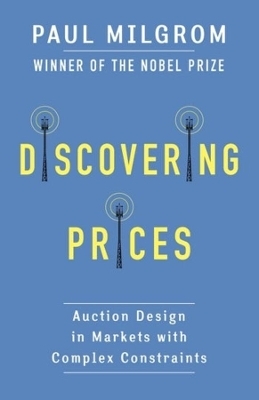
Discovering Prices
Auction Design in Markets with Complex Constraints
Seiten
2021
Columbia University Press (Verlag)
978-0-231-17599-9 (ISBN)
Columbia University Press (Verlag)
978-0-231-17599-9 (ISBN)
Paul Milgrom describes how auctions can be used to discover prices and guide efficient resource allocations. Milgrom roots his new theories in real-world examples (including the ambitious U.S. incentive auction of radio frequencies, whose design he led) and provides economists with crucial new tools for solving complex resource allocation problems.
Traditional economic theory studies idealized markets in which prices alone can guide efficient allocation, with no need for central organization. Such models build from Adam Smith’s famous concept of an invisible hand, which guides markets and renders regulation or interference largely unnecessary. Yet for many markets, prices alone are not enough to guide feasible and efficient outcomes, and regulation alone is not enough, either. Consider air traffic control at major airports. While prices could encourage airlines to take off and land at less congested times, prices alone do just part of the job; an air traffic control system is still indispensable to avoid disastrous consequences. With just an air traffic controller, however, limited resources can be wasted or poorly used. What’s needed in this and many other real-world cases is an auction system that can effectively reveal prices while still maintaining enough direct control to ensure that complex constraints are satisfied.
In Discovering Prices, Paul Milgrom—the world’s most frequently cited academic expert on auction design—describes how auctions can be used to discover prices and guide efficient resource allocations, even when resources are diverse, constraints are critical, and market-clearing prices may not even exist. Economists have long understood that externalities and market power both necessitate market organization. In this book, Milgrom introduces complex constraints as another reason for market design. Both lively and technical, Milgrom roots his new theories in real-world examples (including the ambitious U.S. incentive auction of radio frequencies, whose design he led) and provides economists with crucial new tools for dealing with the world’s growing complex resource-allocation problems.
Traditional economic theory studies idealized markets in which prices alone can guide efficient allocation, with no need for central organization. Such models build from Adam Smith’s famous concept of an invisible hand, which guides markets and renders regulation or interference largely unnecessary. Yet for many markets, prices alone are not enough to guide feasible and efficient outcomes, and regulation alone is not enough, either. Consider air traffic control at major airports. While prices could encourage airlines to take off and land at less congested times, prices alone do just part of the job; an air traffic control system is still indispensable to avoid disastrous consequences. With just an air traffic controller, however, limited resources can be wasted or poorly used. What’s needed in this and many other real-world cases is an auction system that can effectively reveal prices while still maintaining enough direct control to ensure that complex constraints are satisfied.
In Discovering Prices, Paul Milgrom—the world’s most frequently cited academic expert on auction design—describes how auctions can be used to discover prices and guide efficient resource allocations, even when resources are diverse, constraints are critical, and market-clearing prices may not even exist. Economists have long understood that externalities and market power both necessitate market organization. In this book, Milgrom introduces complex constraints as another reason for market design. Both lively and technical, Milgrom roots his new theories in real-world examples (including the ambitious U.S. incentive auction of radio frequencies, whose design he led) and provides economists with crucial new tools for dealing with the world’s growing complex resource-allocation problems.
Paul Milgrom is the Shirley R. and Leonard W. Ely, Jr. Professor of Humanities and Sciences in the Department of Economics at Stanford University. He was awarded the 2020 Nobel Memorial Prize in Economic Sciences. His books include Putting Auction Theory to Work (2004) and Economics, Organization, and Management (1992). He has also written dozens of articles on auction design, game theory, and macro- and microeconomics.
Preface
1. Introduction
2. (Near-)Substitutes, Prices, and Stability
3. Vickrey Auctions and Substitution
4. Deferred-Acceptance Auctions and Near-Substitutes
5. Conclusion
Notes
References
Index
| Erscheinungsdatum | 13.05.2021 |
|---|---|
| Reihe/Serie | Kenneth J. Arrow Lecture Series |
| Verlagsort | New York |
| Sprache | englisch |
| Maße | 140 x 216 mm |
| Themenwelt | Mathematik / Informatik ► Mathematik ► Finanz- / Wirtschaftsmathematik |
| Wirtschaft ► Betriebswirtschaft / Management | |
| ISBN-10 | 0-231-17599-X / 023117599X |
| ISBN-13 | 978-0-231-17599-9 / 9780231175999 |
| Zustand | Neuware |
| Haben Sie eine Frage zum Produkt? |
Mehr entdecken
aus dem Bereich
aus dem Bereich
eine anwendungsorientierte Einführung
Buch | Softcover (2023)
Springer Gabler (Verlag)
CHF 69,95
Buch | Softcover (2023)
De Gruyter Oldenbourg (Verlag)
CHF 41,90


